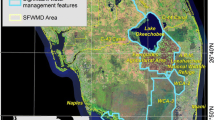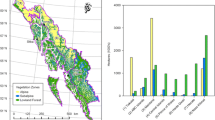Abstract
This article introduces this special journal issue on climate change impacts on Sierra Nevada water resources and provides a critical summary of major findings and questions that remain open, representing future research opportunities. Some of these questions are long standing, while others emerge from the new research reported in the eight research papers in this special issue. Six of the papers study Eastern Sierra watersheds, which have been under-represented in the recent literature. One of those papers presents hydrologic projections for Owens Valley, benefiting from multi-decadal streamflow records made available by the Los Angeles Department of Water and Power for hydrologic model calibration. Taken together, the eight research papers present an image of localized climatic and hydrologic specificity that allows few region-wide conclusions. A source of uncertainty across these studies concerns the inability of the (statistically downscaled) global climate model results that were used to adequately project future changes in key processes including (among others) the precipitation distribution with altitude. Greater availability of regional climate model results in the future will provide research opportunities to project altitudinal shifts in snowfall and rainfall, with important implications to snowmelt timing, streamflow temperatures, and the Eastern Sierra’s precipitation-shadow effect.



Similar content being viewed by others
References
Arismendi I, Johnson SL, Dunham JB, Haggerty R, Hockman-Wert D (2012) The paradox of cooling streams in a warming world: regional climate trends do not parallel variable local trends in stream temperature in the pacific continental United States. Geophys Res Lett 39(L10401). doi:10.1029/2012GL051448
Ault AP, Williams CR, White AB, Neiman PJ, Creamean JM, Gaston CJ, Ralph FM, Prather KA (2011) Detection of Asian dust in California orographic precipitation. J Geophys Res 116(D16205). doi:10.1029/2010JD015351
Budyko MI (1974) Climate and life. Academic, San Diego, 508
Budyko MI, Zubenov LI (1961) Determination of evaporation from the land surface (in Russian). Izv Akad Nauk SSSR Ser Geogr 6:3–17
Cayan D, Tyree M, Dettinger M, Hidalgo H, Das T, Maurer E, Bromirski P, Graham N, Flick R (2009) Climate change scenarios and sea level rise estimates for the 2008 California climate change scenarios assessment. California Energy Commission, Sacramento, p 62
Coats R (2010) Climate change in the Tahoe basin: regional trends, impacts and drivers. Clim Change 102:435–466
Coats RN, Perez-Losada J, Schladow G, Richards R, Goldman CR (2006) The warming of Lake Tahoe. Clim Change 76:121–148
Coats RN, Larsen M, Heyvaert A, Thomas J, Luck M, Reuter J (2008) Nutrient and sediment production, watershed characteristics, and land use in the Tahoe basin, California-Nevada. J Am Water Resour Assoc 44:754–770
Coats R, Costa-Cabral M, Riverson J, Reuter J, Sahoo G, Schladow G, Wolfe B (2012) Projected 21st century trends in hydroclimatology of the Tahoe basin. Clim Change, this Special Issue
Costa-Cabral M, Roy SB, Maurer EP, Mills WB, Chen L (2012) Snowpack and runoff response to climate change in Owens Valley and Mono Lake watersheds. Clim Change, this Special Issue
Daly C, Conklin DR, Unsworth MH (2009) Local atmospheric decoupling in complex topography alters climate change impacts. Int J Climatol. doi:10.1002/joc.2007
Dettinger MD (2012) Projections and downscaling of 21st century temperatures, precipitation, radiative fluxes and winds for the southwestern US, with focus on Lake Tahoe. Clim Change, this Special Issue
Dettinger M, Redmond K, Cayan D (2004) Winter orographic precipitation ratios in the Sierra Nevada – large-scale atmospheric circulations and hydrologic consequences. J Hydrometeor 5:1102–1116
Diffenbaugh NS, Pal JS, Trapp RJ, Giorgi F (2005) Fine-scale processes regulate the response of extreme events to global climate change. Proc Nat Acad Sci 102(44):15774–15778
Ficklin DL, Stewart IT, Maurer EP (2012) Effects of projected climate change on the hydrology in the Mono Lake Basin, California. Clim Change, this Special Issue
Goldman CR (2000) Baldi lecture: four decades of change in two subalpine lakes. Verh Internat Verein Limnol 27:7–26
Hart J (1996) Storm over Mono: the Mono Lake battle and the California water future. University of California Press, Berkeley
IPCC (2007) Climate Change 2007, the Fourth Assessment Report (AR4) of the United Nations ntergovernmental Panel on Climate Change (IPCC). The Physical Science Basis. Available at: http,//www.ipcc.ch/ipccreports/ar4-wg1.htm
Jassby AD, Goldman CR, Reuter JE, Richards RC (1999) Origins and scale dependence of temporal variability in the transparency of lake Tahoe. Limnol Oceanog 44:282–294
Kamerath M, Chandra S, Allen BC (2008) Distribution and impacts of warm water invasive fish in Lake Tahoe, USA. Aquatic Invasions 3(1):35–41. doi:10.3391/ai.2008.1.1.7
Karl TR, Trenberth KE (2003) Modern global climate change. Science 302:1719–1723
Lahontan, NDEP (2010) Lake Tahoe Total Maximum Daily Load Final Report. California Regional Water Quality Control Board, Lahontan Region, Nevada Division of Environmental Protection, Carson City, Nevada
Lundquist JD, Cayan DR (2007) Surface temperature patterns in complex terrain: daily variations and long-term change in the central Sierra Nevada, California. J Geophys Res 112(D11124). doi:10.1029/2008WR007035
Lundquist JD, Pepin N, Rochford C (2008) Automated algorithm for mapping regions of cold-air pooling in complex terrain. J Geophys Res 113(D22107). doi:10.1029/2008JD009879
Lundquist JD, Minder J, Neiman PJ, Sukovich E (2010) Relationships between barrier jet heights, orographic precipitation gradients, and streamflow in the northern Sierra Nevada. J Hydrometeorol 11:1141–1156
Manning MR, Edmonds J, Emori S, Grubler A, Hibbard K, Joos F, Kainuma M, Keeling RF, Kram T, Manning AC, Meinshausen M, Moss R, Nakicenovic N, Riahi K, Rose SK, Smith S, Swart R, van Vuure DP (2010) Misrepresentation of the IPCC CO2 emission scenarios. Letters, Nature Geosci 3
Maurer EP, Brekke L, Pruitt T, Duffy PB (2007) Fine-resolution climate change projections enhance regional climate change impact studies. Eos Trans Am Geophys Union 88(47):504. doi:10.1029/2007EO470006
Milly PCD (1994) Climate, soil water storage, and the average annual water balance. Water Resour Res 30(7):2143–2156
Morelli TL, McGlinchy MC, Neilson RP (2011) A climate change primer for land managers: an example from the Sierra Nevada. Research Paper PSW-RP-262. Department of Agriculture, Forest Service, Pacific Southwest Research Station, Albany, p 44
Nakicenovic N et al (2000) Special report on emissions scenarios. Cambridge U. Press, Cambridge, 570 pp
Null SE, Viers JH, Deas ML, Tanaka SK, Mount JF (2012) Stream temperature sensitivity to climate warming in California’s Sierra Nevada: impacts to coldwater habitat. Clim Change, this Special Issue
Ralph FM, Neiman PJ, Wick GA (2004) Satellite and CALJET aircraft observations of atmospheric rivers over the eastern North Pacific Ocean during the winter of 1997/98. Mon Wea Rev 132:1722–1745
Raupach MR, Marland G, Ciais P, LeQuere C, Canadell JG, Field CB (2007) Global and regional drivers of accelerating CO2 emissions. Proc Natl Acad Sci U S A (PNAS). doi:10.1073/pnas.0700609104
Riverson J, Coats R, Costa-Cabral M, Dettinger M, Reuter J, Sahoo G, Schladow G, Wolfe B (2012) Modeling the impacts of climate change on streamflow, nutrient and sediment loads in the Tahoe Basin. Clim Change, this Special Issue
Sahoo GB, Schladow SG (2008) Impacts of climate change on lakes and reservoirs dynamics and restoration policies. Sustain Sci 3(2):189–200
Sahoo GB, Schladow SG, Reuter JE (2010a) Effect of sediment and nutrient loading on Lake Tahoe (CA-NV) optical conditions and restoration opportunities using a newly developed lake clarity model. Water Resour Res. doi:10.1029/2009WR008447
Sahoo GB, Schladow SG, Reuter JE, Coats R (2010b) Effects of climate change on thermal properties of lakes and reservoirs, and possible implications. Stoch Env Res Risk A (SERRA). doi:10.1007/s00477-010-0414-z
Sahoo G, Schladow G, Reuter JE, Coats R, Dettinger M, Riverson J, Wolfe B, Costa-Cabral M (2012) The response of Lake Tahoe to climate change. Clim Change, this Special Issue
Serreze MC, Clark MP, Armstrong RL, McGinnis DA, Pulwarty RS (1999) Characteristics of the western United States snowpack from snowpack telemetry (SNOTEL) data. Water Resour Res 35:2145–2160
SNEP (SNEP Science Team and Special Consultants, University of California) (1996) The Sierra Nevada Ecosystem Project: Final Report to Congress. http://ceres.ca.gov/snep/
Stewart IT (2012) Connecting physical watershed characteristics to climate sensitivity for California mountain streams. Clim Change, this Special Issue
Swift TJ, Perez-Losada J, Schladow SG, Reuter JE, Jassby AD, Goldman CR (2006) Water clarity modeling in Lake Tahoe: linking suspended matter characteristics to secchi depth. Aquat Sci 68:1–15
TERC (2011) Lake Tahoe Clarity. At: http://terc.ucdavis.edu/research/clarity.html Accessed 8/30/2011
Tetra Tech (2010) Upland Sources – Lake Tahoe Total Maximum Load Technical Report (Section 4–3). In Lake Tahoe Total maximum Daily Load Final Report. California Regional Water Quality Control Board, Lahontan Region, Nevada Division of Environmental Protection, Carson City NV: 4–23 to 4–99 pp
Underwood SJ, Kaplan ML, King KC (2009) The role of upstream midtropospheric circulations in the Sierra Nevada enabling leeside (spillover) precipitation. Part I: a synoptic-scale analysis of spillover precipitation and flooding in a leeside basin. J Hydrometeorol 10:1309–1326. doi:10.1175/2009JHM1105.1
Wittmann M, Reuter J, Schladow SG, Hackley SH, Allen BC (2008) Asian clam (Corbicula fluminea) of Lake Tahoe: preliminary scientific findings in support of a management plan. U. California Tahoe Environmental Research Center, Davis
Wolfe B (2010) Implications of climate change for design of BMPs in the Lake Tahoe basin. In: Coats R, Reuter J (eds) The Effects of Climate Change on Lake Tahoe in the 21st Century. Meteorology, Hydrology, Loading and Lake Response. University of California, Davis, Tahoe Environmental Research Center and Department of Environmental Science & Policy, Davis, pp 68–80
Wood AW, Maurer EP, Kumar A, Lettenmaier DP (2002) Long-range experimental hydrologic forecasting for the eastern United States. J Geophys Res 107(D20):4429. doi:10.1029/2001JD000659
Acknowledgements
We thank Jessica Lundquist for her review, the literature references she indicated, and for helping identify some of the future research opportunities. We thank Michael Dettinger for downscaling the GCM output, and providing helpful advice on the Tahoe project. This manuscript also benefited from two anonymous reviews.
Author information
Authors and Affiliations
Corresponding author
Additional information
This article is part of a Special Issue on Climate Change and Water Resources in the Sierra Nevada edited by Robert Coats, Iris Stewart, and Constance Millar.
Rights and permissions
About this article
Cite this article
Costa-Cabral, M., Coats, R., Reuter, J. et al. Climate variability and change in mountain environments: some implications for water resources and water quality in the Sierra Nevada (USA). Climatic Change 116, 1–14 (2013). https://doi.org/10.1007/s10584-012-0630-2
Received:
Accepted:
Published:
Issue Date:
DOI: https://doi.org/10.1007/s10584-012-0630-2




